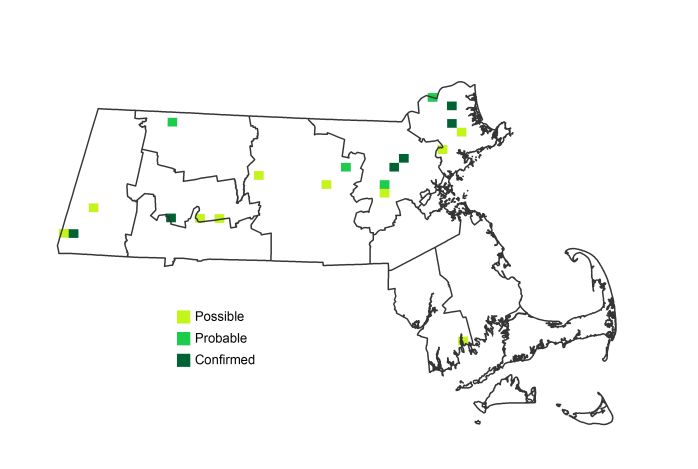Find a Bird
Pied-billed Grebe
Podilymbus podiceps

Very local and likely increasing
Action/monitoring needed
Endangered Species
“The wings of Time are black and white, / Pied with morning and with night.” – Ralph Waldo Emerson, Compensation
This nocturnal migrant is commonly seen floating in small groups when stopping over during migration, yet it is secretive when breeding. Pied-billed Grebes are marsh specialists that have declined statewide as wetlands have given way to development. Indeed, the Pied-billed Grebe is listed as an Endangered Species in the Commonwealth. Massachusetts wetlands are now protected by law, but will this be enough to save our state’s only breeding grebe species from becoming just another memory, or will Pied-billed Grebes be swept up by the “pied wings of Time”?
Historic Status
Already beset by attacks from hawks above and snapping turtles below, Pied-billed Grebes historically found their worst enemy in Massachusetts to be humanity. A freshwater marsh nester, the Pied-billed Grebe suffered from extensive habitat loss during the eighteenth century, when beavers were extirpated and farmers ploughed under wetlands for the creation of arable land. Moreover, Forbush claimed that “in the old days of flintlock guns the bird dived at the flash in the pan and eluded the shot,” (Forbush 1925) but as weapons technologically improved, grebes lost their edge, and oftentimes their lives. Brewster reported Pied-billed Grebes thriving at Great Meadows in Concord in the 1890s (Bent 1919) but elsewhere in the state their population declined dramatically as they were wantonly hunted.
Atlas 1 Distribution
By the time of Atlas 1, Pied-billed Grebes continued to breed in a few isolated areas in the Berkshire Highlands and Marble Valleys, but other than that no grebes were found anywhere in the western half of the state. The birds were similarly sparsely distributed in the east, with the Coastal Plains having the largest number of occupied blocks (6), fully half of which were accounted for by Parker River National Wildlife Refuge and surrounding environs. A small handful of blocks in the Bristol/Narragansett Lowlands and Cape Cod completed the picture of a species much reduced from historic levels.
Atlas 2 Distribution and Change
There seems to be little obvious logic behind the erratic nesting habits of Pied-billed Grebes in Massachusetts, at least as reflected in the maps comparing Atlas 1 to Atlas 2. Since grebes seem to be heavily dependent on protected wetlands, one would expect that stricter wetland protection and the species’ listing as Endangered in Massachusetts would have allowed the grebe to rebound. Instead, grebes appear to be in roughly the same number of occupied blocks that existed thirty years ago, although in different locations. The species’ lack of persistence at most sites is troubling and makes recovery and monitoring especially difficult.
Atlas 1 Map

Atlas 2 Map

Atlas Change Map

Ecoregion Data
Atlas 1 | Atlas 2 | Change | ||||||
Ecoregion | # Blocks | % Blocks | % of Range | # Blocks | % Blocks | % of Range | Change in # Blocks | Change in % Blocks |
Taconic Mountains | 0 | 0.0 | 0.0 | 1 | 4.0 | 5.0 | 1 | 6.7 |
Marble Valleys/Housatonic Valley | 1 | 2.6 | 7.7 | 2 | 5.1 | 10.0 | 1 | 2.6 |
Berkshire Highlands | 2 | 3.6 | 15.4 | 1 | 1.8 | 5.0 | -1 | -1.9 |
Lower Berkshire Hills | 0 | 0.0 | 0.0 | 0 | 0.0 | 0.0 | 0 | 0.0 |
Vermont Piedmont | 0 | 0.0 | 0.0 | 0 | 0.0 | 0.0 | 0 | 0.0 |
Berkshire Transition | 0 | 0.0 | 0.0 | 1 | 2.5 | 5.0 | 1 | 3.2 |
Connecticut River Valley | 0 | 0.0 | 0.0 | 1 | 1.5 | 5.0 | 0 | 0.0 |
Worcester Plateau | 0 | 0.0 | 0.0 | 0 | 0.0 | 0.0 | 0 | 0.0 |
Lower Worcester Plateau | 0 | 0.0 | 0.0 | 2 | 2.5 | 10.0 | 1 | 1.9 |
S. New England Coastal Plains and Hills | 6 | 2.2 | 46.2 | 11 | 3.9 | 55.0 | 1 | 0.4 |
Boston Basin | 0 | 0.0 | 0.0 | 0 | 0.0 | 0.0 | 0 | 0.0 |
Bristol and Narragansett Lowlands | 2 | 1.9 | 15.4 | 1 | 0.9 | 5.0 | -2 | -2.0 |
Cape Cod and Islands | 2 | 1.5 | 15.4 | 0 | 0.0 | 0.0 | -2 | -1.7 |
Statewide Total | 13 | 1.3 | 100.0 | 20 | 1.9 | 100.0 | 0 | 0.0 |



